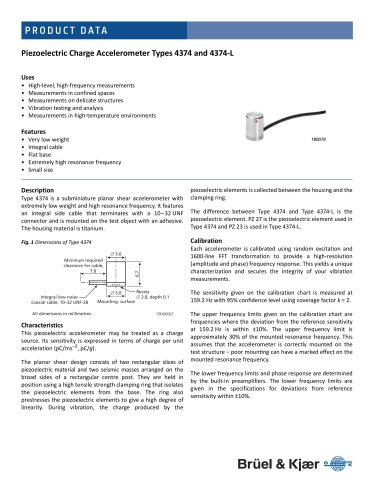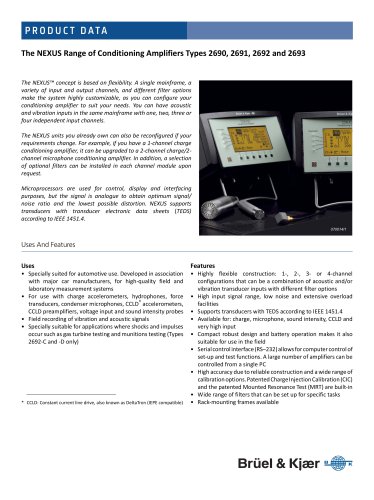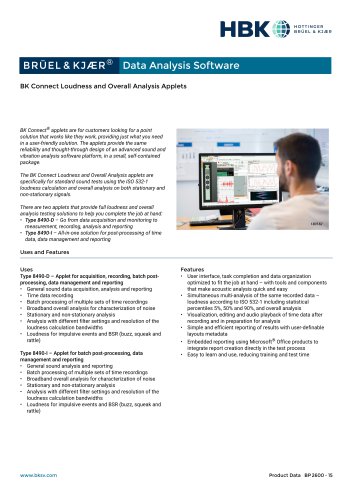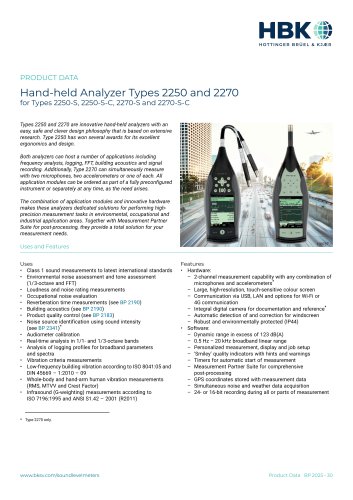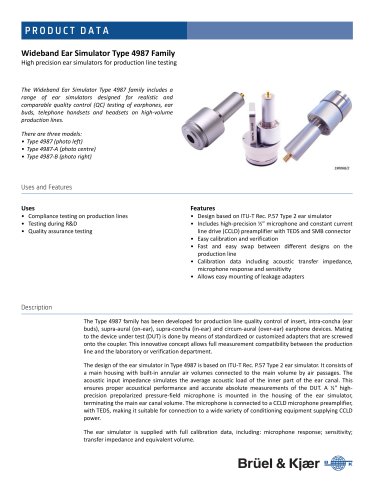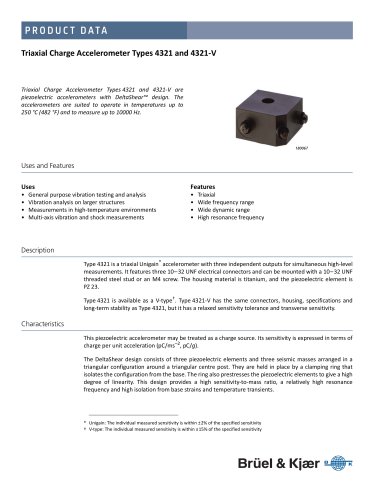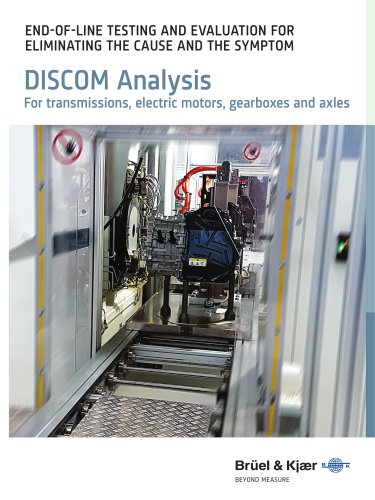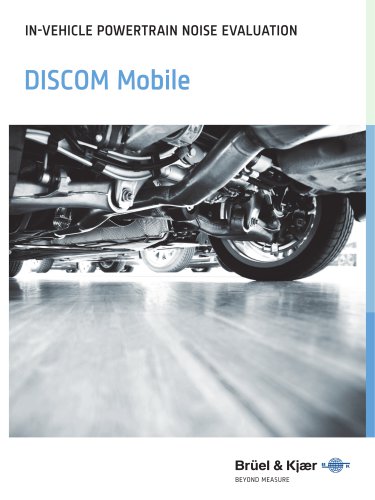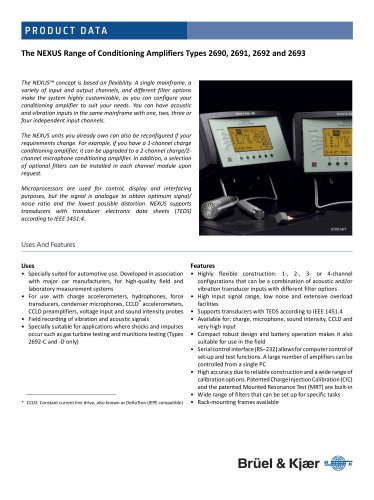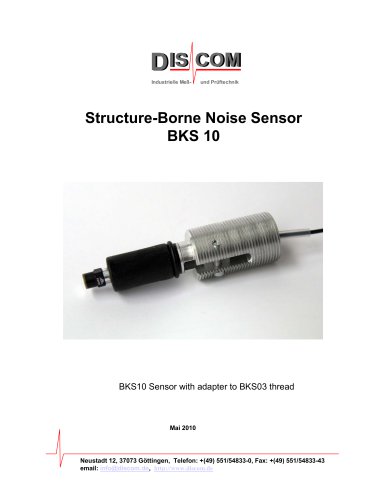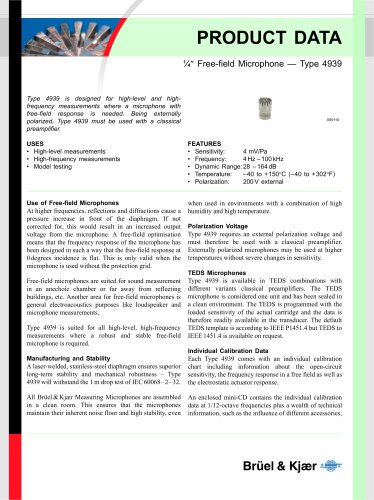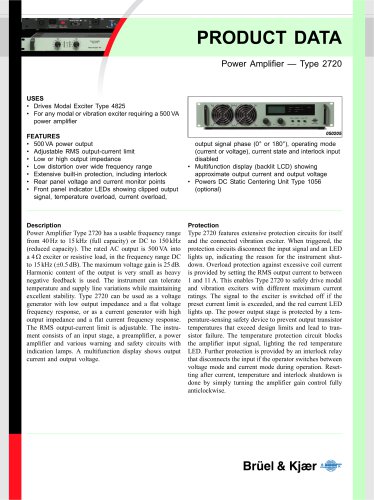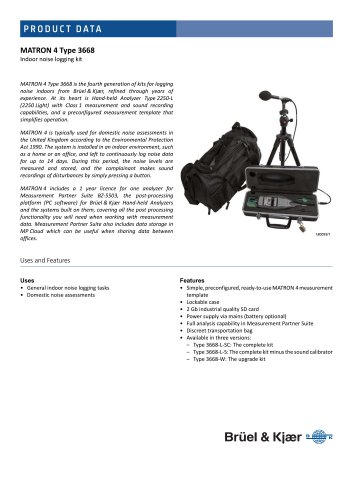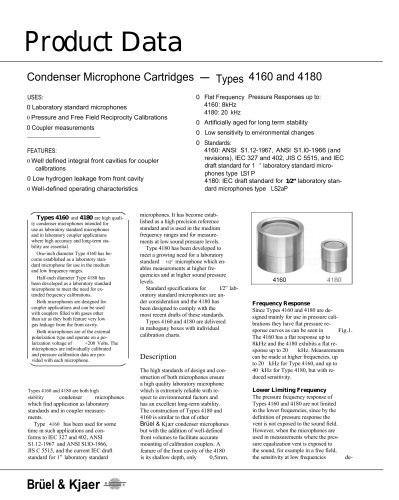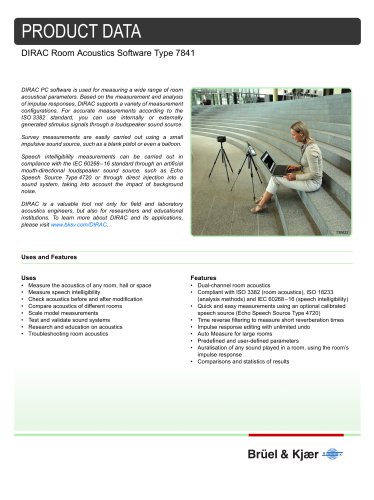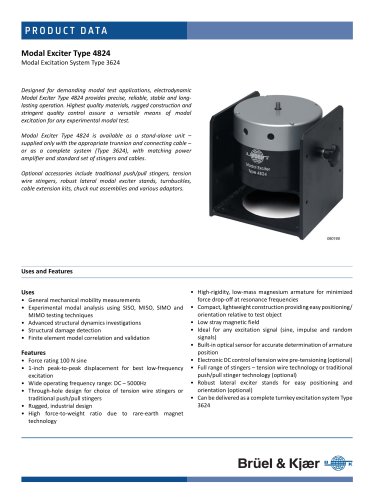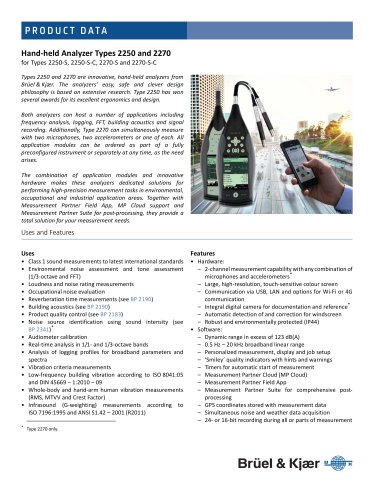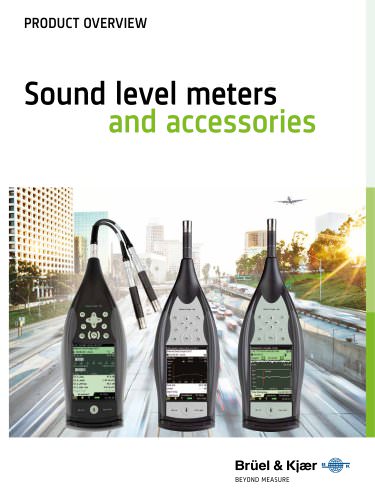
Catalog excerpts

P R O D U C T D ATA Piezoelectric Charge Accelerometer Types 4374 and 4374-L Uses • • • • • High-level, high-frequency measurements Measurements in confined spaces Measurements on delicate structures Vibration testing and analysis Measurements in high-temperature environments Very low weight Integral cable Flat base Extremely high resonance frequency Small size Description Type 4374 is a subminiature planar shear accelerometer with extremely low weight and high resonance frequency. It features an integral side cable that terminates with a 10–32 UNF connector and is mounted on the test object with an adhesive. The housing material is titanium. Each accelerometer is calibrated using random excitation and 1600-line FFT transformation to provide a high-resolution (amplitude and phase) frequency response. This yields a unique characterization and secures the integrity of your vibration measurements. Minimum required clearance for cable, 7.0 The difference between Type 4374 and Type 4374-L is the piezoelectric element. PZ 27 is the piezoelectric element used in Type 4374 and PZ 23 is used in Type 4374-L. Integral low-noise coaxial cable, 10–32 UNF-2B piezoelectric elements is collected between the housing and the clamping ring. Characteristics This piezoelectric accelerometer may be treated as a charge source. Its sensitivity is expressed in terms of charge per unit acceleration (pC/ms–2, pC/g). The planar shear design consists of two rectangular slices of piezoelectric material and two seismic masses arranged on the broad sides of a rectangular centre post. They are held in position using a high tensile strength clamping ring that isolates the piezoelectric elements from the base. The ring also prestresses the piezoelectric elements to give a high degree of linearity. During vibration, the charge produced by the The sensitivity given on the calibration chart is measured at 159.2 Hz with 95% confidence level using coverage factor k = 2. The upper frequency limits given on the calibration chart are frequencies where the deviation from the reference sensitivity at 159.2 Hz is within ±10%. The upper frequency limit is approximately 30% of the mounted resonance frequency. This assumes that the accelerometer is correctly mounted on the test structure − poor moun ng can have a marked effect on the mounted resonance frequency. The lower frequency limits and phase response are determined by the built-in preamplifiers. The lower frequency limits are given in the specifications for deviations from
Open the catalog to page 1
Fig. 2 Typical frequency (left) and high-frequency (right) response curves for Type 4374 Sensitivity [%] Phase [Degrees] Amplitude Phase Phase [Degrees] Amplitude Phase Specifications – Charge Accelerometer Types 4374 and 4374-L Ordering Information All values are typical at 25 °C (77 °F) unless measurement uncertainty is stated Type 4374 Type 4374-L Both types include the following: • Carrying box • Calibration chart • AO-0038-D-012: Low-noise coaxial cable, 10–32 UNF connectors, length 1.2 m • JJ-0032: Adapter, 10–32 UNF (F) connectors Frequency Range (±10% limit) Mounted Resonance...
Open the catalog to page 2All Bruel and Kjaer catalogs and technical brochures
-
Data Analysis Software
6 Pages
-
B&K 2245 Sound Level Meter
8 Pages
-
HBK 2255 Sound Level Meter
10 Pages
-
Artificial Mastoid Type 4930
6 Pages
-
Power Amplifier Type 2718
2 Pages
-
DISCOM Mobile
6 Pages
-
DISCOM NVH Analysis Systems
4 Pages
-
TEDS Microphones
8 Pages
-
LDS V8
4 Pages
-
LDS Comet USB
4 Pages
-
LDS Laser USB
16 Pages
-
2690-A
16 Pages
-
4326-A-001
8 Pages
-
4152
4 Pages
-
4191
2 Pages
-
2719
2 Pages
-
LDS V8900
4 Pages
-
BKS 10
8 Pages
-
1704-A-001
4 Pages
-
4939
2 Pages
-
4138
4 Pages
-
4101-B and 4965-B
4 Pages
-
Sonoscout NVH Recorder
8 Pages
-
LDS Power Amplifiers
8 Pages
-
Type 2720
2 Pages
-
Type 2721
2 Pages
-
TYPE 3668
4 Pages
-
3656-A
4 Pages
-
TYPE 2270-S
28 Pages
-
LDS V994
2 Pages
-
TYPE 8702
16 Pages
-
BZ-7848-A
40 Pages
-
TYPE 9718-A:bp0317
12 Pages
-
TYPE 4720:bp1974
12 Pages
-
TYPE 4824:bp1936
4 Pages
-
SOUND LEVEL METER:bp 2025
28 Pages
-
Transducers and conditioning
188 Pages
-
Noise Sentinel Overview
3 Pages
-
Analyzer Catalogue
39 Pages
-
Noise Logger Type 3659
1 Pages
-
Sound level meters
17 Pages

